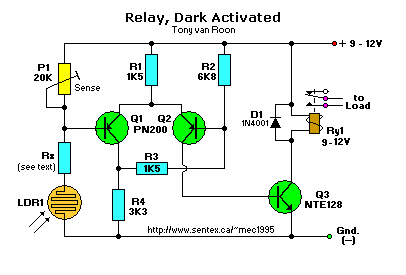
Dark Activated Relay
Parts List:
Resistors are 1/4 Watt, 5%
R1,R3 = 1K5
R2 = 6K8
R4 = 3K3
Rx = 1K-10K (see text. I used 3K3)
P1 = 20K, trimmer pot
LDR1 = Light Depending Resistor
Q1,Q2 = PN200, 2N3906, NTE159, 2N4403, etc.
Q3 = 2N3053, 2N2219, 2N699, NTE128, etc.
D1 = 1N4001
Ry1 = Relay, 9-12V
Notes:
This circuit switches a relay at dark via a Light Dependent Resistor or LDR for short.
The applications are numerous. In my application, it switches on a light with an older type movement sensor and is
mounted on the top corner of my workshop with the LDR facing upwards. The Dark Activated Relay prevents that the light
is triggered during daylight hours. But, it can also be used to switch led-beacon lights for your driveway, or
whatever.
The LDR, Rx, and P1 are connected in series to accommodate different ambient/dark levels. Q1 and Q2 are wired as a
trigger flip-flop; when Q1 is on, Q2 is off and vice-versa. R1 gives some positive feedback to the emitters of Q1 and
Q2. The resistance of the LDR during daylight is much higher than the 20K trimmer and Rx and will produce a voltage at
Q1 higher than the base voltage of Q2 which will activate the relay. The type I used myself is a Potter&Brumfield
relay, 12V/10A, model T7NS5D1-12, and cost only a couple bucks. As a power source I use a 12 volt/500mA adapter.
For Rx I used a 3K3 resistor to accommodate the LDR type I'm using. It may not be needed for your own scenario and
in that case use a 1K resistor for Rx. Trim pot P1 will ajust the 'dark' sensitivity.
The current draw during off-state (daylight) is about 3mA standby-current, draw during dark is only 130mA, depending on
your selection of Ry1, and semiconductors.
I will make a printed circuit board and layout sometime later this year.
Back to Circuits page
Copyright © 1995 -- Tony van Roon
Last updated January 23, 2009

